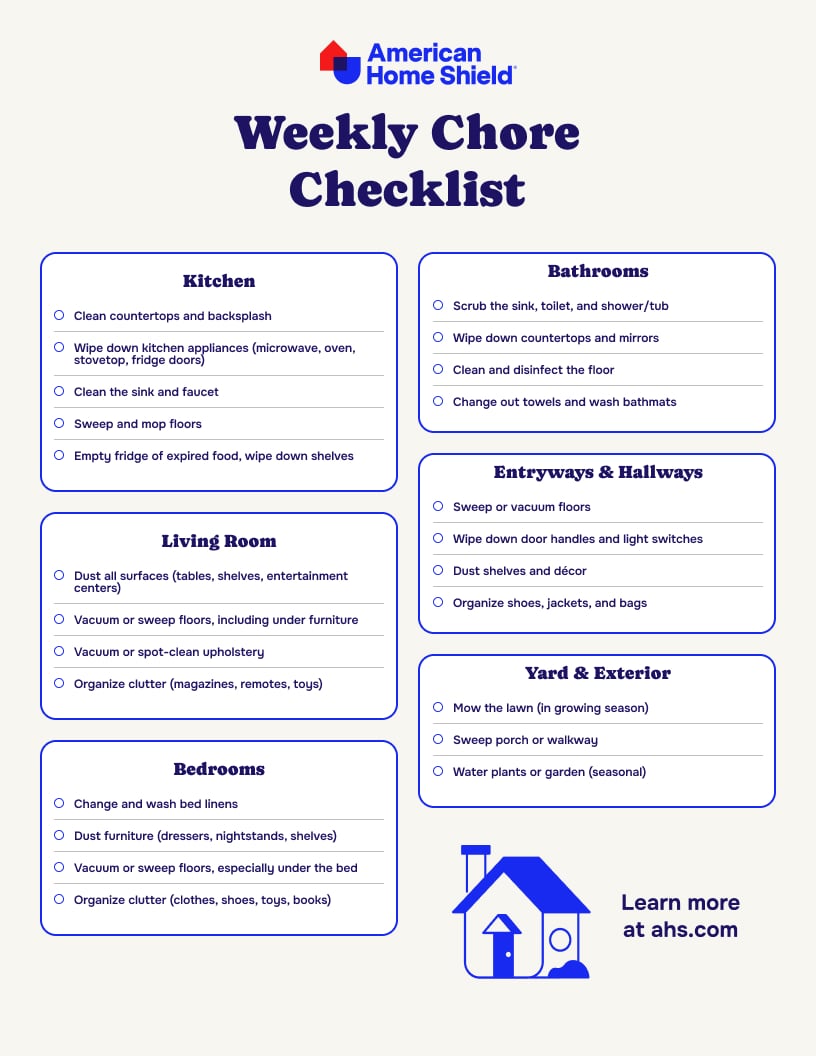How to Create a Weekly Chore Schedule
Sometimes, it feels like chores never end—especially when you’re staring at that sink full of dishes. While housework can be monotonous, putting a weekly housework schedule in place can make all the difference.

Whether you’re looking to divide tasks fairly among family members, roommates, or just keep things organized in your own space, we’ve got your complete guide to breaking down your weekly house cleaning checklist and getting some time back in your day.
Assess household needs
No two households are the same, and your home might have certain unique aspects that impact the way you clean it. Start by making a chore list of everything you tend to that requires regular attention — think both cleaning and maintenance tasks. Break it down like this:
Daily tasks
These are the little things that help keep clutter and chaos from taking over. Tidying up living spaces, doing dishes, wiping down kitchen counters, and quickly sweeping high-traffic areas count as jobs you need to get done everyday to keep the house under control.
Weekly tasks
These chores dig a little deeper, like vacuuming or mopping floors, cleaning bathrooms, and tackling laundry. These are the jobs that, if left too long, can make your home feel a little grimy — but doing them every single day might be overkill.
Monthly tasks
Once a month or so, you’ll want to address those less noticeable areas. This could mean dusting ceiling fans, cleaning out light fixtures, or wiping down baseboards. Jobs like this are easy to forget, but keeping up with them makes a huge difference in how clean your home feels.
Seasonal tasks
Don’t forget those big jobs that only roll around once in a while! Gutter cleaning, deep-cleaning carpets, and swapping out seasonal bedding are all examples. They help transition your house to a new season, while accounting for the new challenges that come along with that change.

Distribute chores fairly
Now that you’ve assessed what needs to be done, it’s time to flesh out your weekly chore chart by assigning tasks. The goal here is balance — nobody should feel like they’re carrying the load alone.
For families with kids
Chores can be a great way to teach responsibility, but they need to be age-appropriate. Younger kids can help with tasks like picking up toys or wiping surfaces, while older kids can handle vacuuming, folding laundry, or even taking out the trash. Check out our blog resource for more tips on how to make a chore chart for your kids.
For couples or roommates
Without kids in the picture, it’s best to divide chores based on availability, schedules, and preferences. Maybe one person loves cooking but hates doing the dishes, or one has more free time in the mornings. If everyone has more flexibility, you could rotate tasks weekly to keep things fresh. The key is to make sure that no one is consistently stuck with the more time-consuming or less enjoyable jobs.
Create a weekly housework schedule
Once you've divided chores fairly, the next step is to create a weekly chore schedule that everyone can follow. No matter whether you try out an app or stick to an old-school chart, having a clear, visible schedule keeps things running smoothly. A formal chore list helps hold everyone accountable and prevents those "I didn't know it was my turn" conversations.
Make your weekly chore schedule work for your household with these tips:
Use a shared digital calendar
If your household is already in sync with digital tools, a shared online calendar is an easy way to stay on top of recurring household tasks. A shared Google Calendar, or similar, lets you assign tasks to specific people on set days and even set reminders to nudge everyone when it's time to tackle a task.
Download a task app
If you want something a little more tailored to the task at hand, try out an app designed specifically to manage household tasks, like Todoist, Trello, or Cozi. These apps allow you to assign chores, set deadlines, and even check off tasks as they're completed. This way, everyone gets real-time updates when a chore’s completed, and it’s obvious what’s left to do. Plus, there’s nothing like the satisfaction of hitting “complete” on a task to feel like you’ve crushed your day!
Build a visual chore chart
Sometimes the best solution is the most obvious. A visual weekly chore chart (on a whiteboard, chalkboard, or even a printed sheet on the fridge) gives everyone a quick at-a-glance view of what needs to be done. This is especially great for families with young children or households where everyone’s schedules are all over the place — it’s instantly visible, and you can get creative as you want by making it colorful or adding rewards for completed tasks.
Weekly house cleaning checklist by room: The kitchen
It’s no secret that the kitchen is the heart of your home, and that’s why it gets messy fast. With all that foot traffic, it’s important to keep this space under control with daily upkeep and a deeper weekly clean.
Daily tasks:
- Wipe down countertops after meals.
- Sweep the floor to catch crumbs and spills.
- Wash dishes or load the dishwasher every night.
Weekly tasks:
- Deep clean the sink and faucet.
- Clean out the refrigerator (toss old food, wipe down shelves).
- Mop the kitchen floor.
Monthly/Seasonal tasks:
- Wipe down the inside of the microwave.
- Clean the oven and stovetop thoroughly.
- Organize pantry shelves and wipe them down.

Living room
The living room is where you unwind, binge-watch your favorite shows, or catch up with friends and family. But between throw pillows, blankets, and whatever else sneaks in there, it’s easy for clutter to take over. Follow this weekly chore list to keep your living space cozy.
Daily tasks:
- Tidy up throw blankets, pillows, and toys (if applicable).
- Dust surfaces like coffee tables and remotes.
Weekly tasks:
- Vacuum or sweep floors.
- Dust surfaces, including shelves and electronics.
- Wipe down light switches and remote controls.
Monthly/Seasonal tasks:
- Clean windows and dust blinds.
- Rotate and fluff couch cushions.
- Deep clean carpets or rugs.

Bedrooms
Your bedroom should be a calm, peaceful retreat from the world, not a place haunted by overdue cleaning tasks. Regular upkeep will help keep it that way.
Daily tasks:
- Make the bed every morning.
- Put away clothes, shoes, and any clutter.
Weekly tasks:
- Change and wash bed linens.
- Dust surfaces (nightstands, dressers).
- Vacuum or sweep the floor
Monthly/Seasonal tasks:
- Rotate mattresses (if needed).
- Deep clean or launder curtains.
- Organize closets and donate unused clothes.

Bathrooms
Bathrooms can quickly go from sparkling clean to grimy, thanks to regular use by everyone in the household. By keeping up with a simple routine of daily tidying and weekly deep cleans, you can prevent build-up and maintain a fresh, sanitary space.
Daily tasks:
- Wipe down sinks and counters after use.
- Clean mirrors to prevent streaks and water spots.
Weekly tasks:
- Scrub the toilet, shower, and sink thoroughly.
- Replace towels with fresh ones.
- Mop the floors and wipe down baseboards.
Monthly/Seasonal tasks:
- Deep clean grout and tiles.
- Replace or deep clean shower curtains/liners.
- Organize cabinets and drawers.

Entryways and Hallways
Your entryway is the first thing people see when they walk in, so keeping it neat and welcoming makes a huge difference. And hallways are often overlooked in your day-to-day cleans, but can collect dirt and dust just like any other room.
Daily tasks:
- Tidy up shoes, jackets, and bags.
- Sweep or vacuum the floor to prevent dirt from spreading.
Weekly tasks:
- Wipe down doors, knobs, and light switches.
- Vacuum or mop the floors, especially if your entryway gets muddy or snowy.
Monthly/Seasonal tasks:
- Clean and organize coat closets.
- Wipe down walls and baseboards to remove scuff marks.
- Swap out seasonal gear like umbrellas, hats, or boots as needed.

Yard and exterior maintenance
Yard and exterior maintenance might not be daily chores, but regular upkeep helps you avoid bigger problems down the road and keeps your home looking its best from the curb.
Weekly tasks:
- Sweep the porch and walkways.
- Take out the trash and recycling.
Monthly/Seasonal tasks:
- Rake leaves in the fall, or shovel snow in the winter.
- Clean gutters and downspouts to prevent clogs.
- Power wash siding, patios, or outdoor furniture when needed.
Own your clean routine with American Home Shield®
Keeping your home clean can feel like a never-ending battle, and we commend you for fighting the good fight. But some battles are bigger than even the best DIY cleaning solution can handle. When your covered major home systems and appliances break down, American Home Shield® has your back. With an American Home Shield home warranty plan, you’ll be ready for whatever your home throws at you, so you can get back to winning the weekly war against clutter.
AHS assumes no responsibility, and specifically disclaims all liability, for your use of any and all information contained herein.
Don't worry. Be warranty.
Have a plan for your home when things don't go according to plan
Shop Home Warranties


